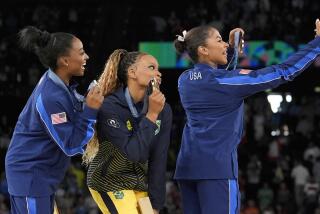COMMENTARY : Will Women Pay Price for Respect in Basketball?
“Women’s TV Sports Tug at Purse Strings,” says a recent headline in the Washington Post. The piece that follows attempts to make a case for women’s college basketball to be marketed to the hilt and put on the map just as is happening in the men’s game.
Let’s pause a minute right there. At the same time that a flood of articles extolling the idea that women’s Division I basketball had finally arrived, “60 Minutes” presented a devastating expose of the money-grubbing and hypocrisy that prevails in the men’s game.
Is there something wrong here? Should the promoters of the women’s game really be proud that they are on the road to matching all the vices of the men.
Just what are those wonderful elements in the men’s game that the women seem so eager to emulate? They are evasive about the excessive demands placed on the student-athlete’s time, an over-aggressive approach by coaches to get to the Final Four at any cost, a downplaying of academic achievement and an emphasis on promotion and hype to bring in revenue, and a blatant conflict-of-interest among coaches, many of whose loyalty to shoe companies supersedes that toward the universities paying their salaries.
Is this what the “liberation” of the woman college athlete is all about? Where are the naysayers? They don’t exist. Their voices have been smothered by the Big Sports monolith.
Nothing better illustrates that women’s college basketball is headed in the wrong direction than a recent “Frontline” documentary on PBS.
Ostensibly, the purpose of this report was to “look at the obstacles facing women’s athletic programs in universities,” but in actuality it was a best-case scenario, which followed the Stanford University women’s basketball team to two recent national championships.
I was, frankly, horrified at the manner in which “Frontline” unquestioningly spelled out what it considered the ingredients that make for a “successful” athletic program for women. What actually came across was an unintentional sick parody of all the human and institutional negatives of the men’s Division I basketball factories.
Much of the footage focused on the Stanford coach, Tara VanDerveer, a kind of female Vince Lombardi without the charisma. The image that she projected was that of a control freak who felt no qualms about telling her team, in no uncertain terms, “I want this national championship bad.” Her manic drive to win, unrelieved by humor, was relentless.
As this hyped-up Stanford team rolled up the score on lesser opponents and marched on to the Final Four, the players, rather than enjoying the experience, became increasingly tense. When they got to the championship round, they were wound up so tightly that they seemed ready to roll on the floor, kicking and screaming.
After gathering all the marbles, the players had still not wound down. Several decided to join women’s professional circuits in Europe, thus confirming the discredited college-basketball-as-pro-farm-club notion. Only two decided to pursue the careers for which their college education had prepared them. If this sounds depressingly familiar, it is.
Assuming from all this that women’s college basketball is on a slippery slope, what alternative to the men’s game is there? Before answering the question, we need to examine the illogical reasoning that has marked the women’s game as “inferior.” Consider these arguments:
* The women’s game is too slow. The problem is that the men’s game is too fast. The run-and-shoot game is not much fun to watch.
* The women can’t dunk. Dunking is irrelevant, so far as good basketball goes. It is nothing more than an excuse for exhibitionism. The women are better off without it. Basketball was never intended to be played “above the rim.”
* The power element is missing in the women’s game. So who needs it. The power game of the men is mindless. Without it, skill and intelligence are maximized.
* Women’s basketball does not bring in much revenue. Neither do fencing or badminton, but they are both world-class sports with a rich tradition and a loyal following.
The mad pursuit of Division I women to achieve semi-professional athletic status while supposedly getting an education strikes me as a horrendous mistake. Therefore, one can only wonder why they haven’t come up with a viable, more humane alternative to what the basketball factories are producing. For starters, I would suggest the implementation of the following ideas:
* Forget about “March Madness” and getting to the Final Four.
* Reduce practice time, travel, and postseason play so athletes can concentrate on their studies.
* Discourage from participation any woman who considers the college team a farm club for the pros.
* Hire coaches who favor the pronoun we rather than I , whose philosophy is, “We want to win, but we want to have fun doing so,” rather than, “I want this win bad.”
* Stop worrying about whether or not you are filling the arenas with revenue-producing fans. Just play the game and enjoy the competition.
* Keep in mind the axiom: Our game is not inferior to that of the men. It is just different.
Ultimately, the promoters of big-time women’s college basketball will have to decide where their loyalty lies--with their respective alma maters or with the TV networks, the shoe companies and the marketing CEOs of big corporations. College women athletes say what they really want is respect. We shall see what path they choose to get it.
More to Read
Go beyond the scoreboard
Get the latest on L.A.'s teams in the daily Sports Report newsletter.
You may occasionally receive promotional content from the Los Angeles Times.










